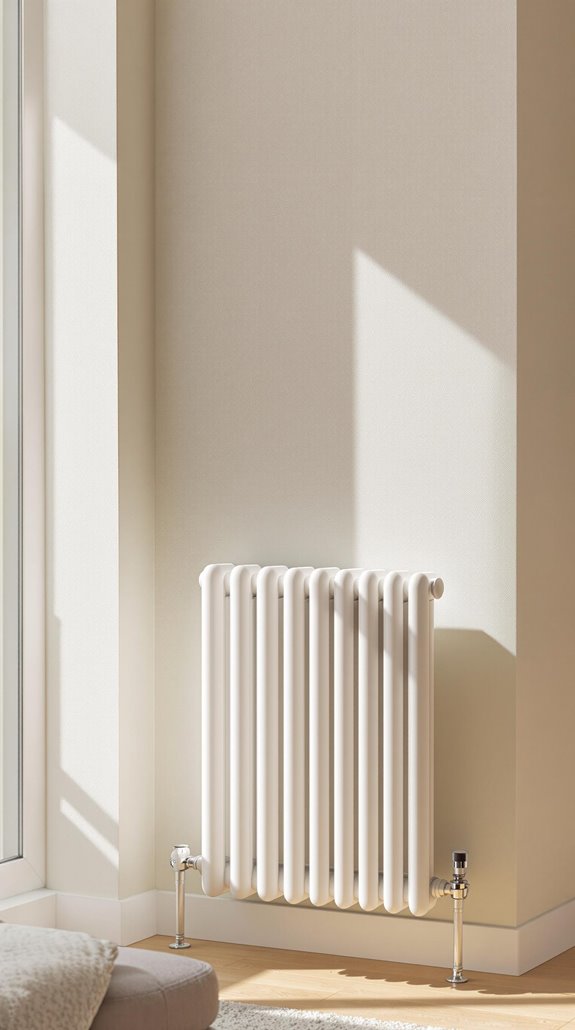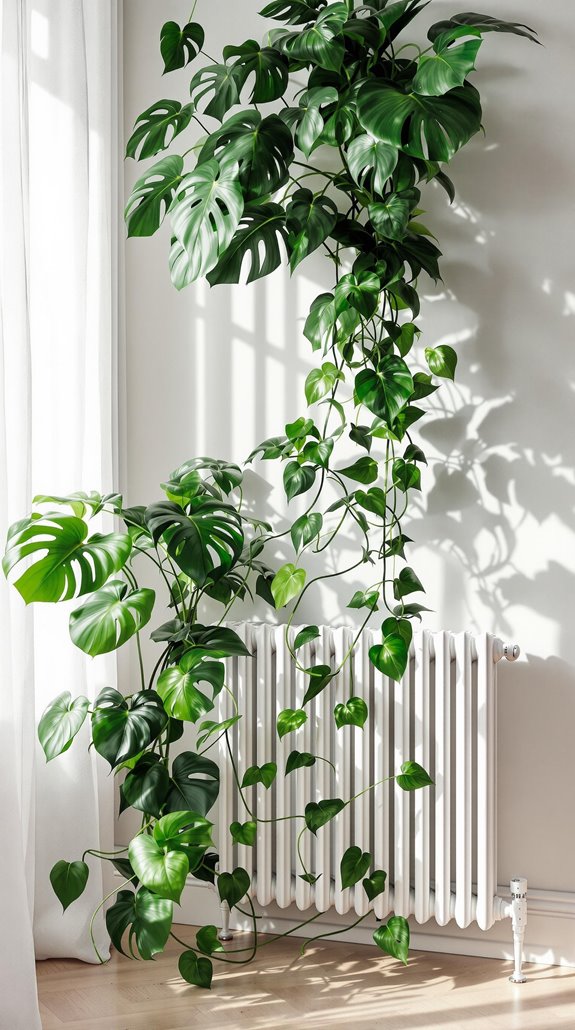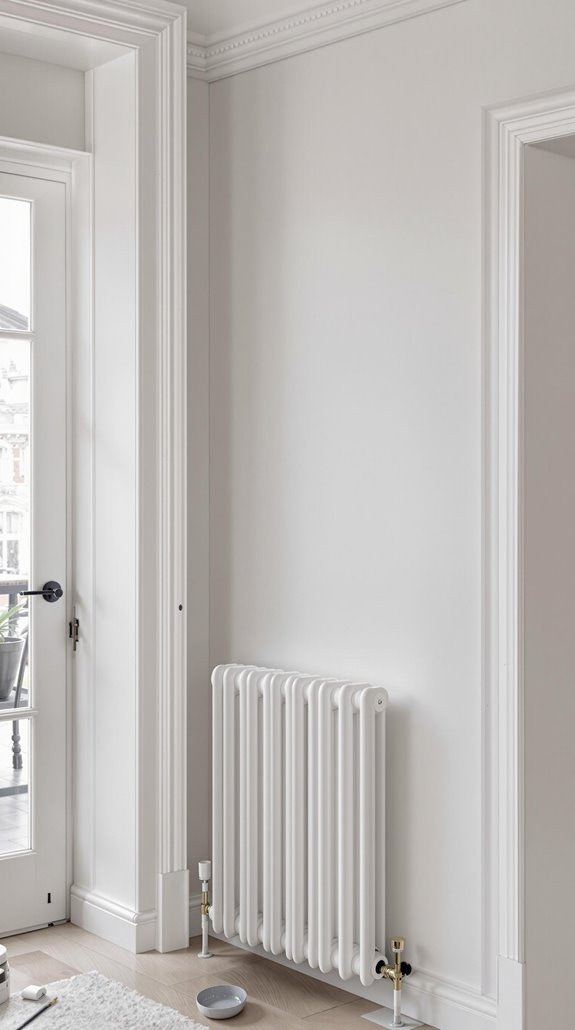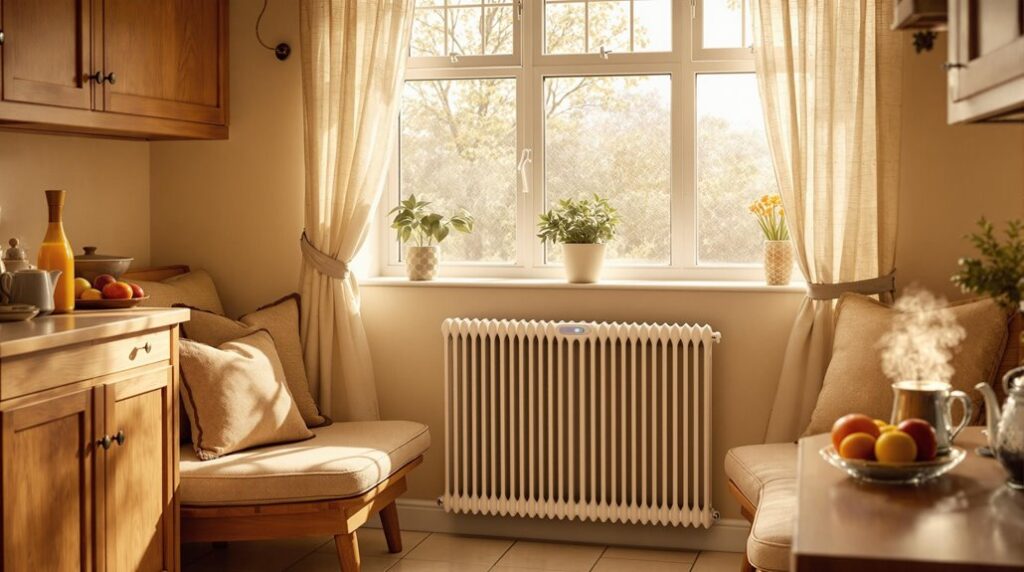I’ve dealt with unsightly radiator pipes ruining my wall’s clean lines more times than I’d like to admit. You’re probably staring at those same exposed pipes right now, wondering how to make them disappear without calling in expensive contractors or tearing apart your walls. The good news is there are several clever solutions I’ve tested that’ll transform your space from amateur to polished – and most require just basic tools you likely already own.
Key Takeaways
- Paint pipes the same color as your wall to create a camouflage effect that makes them blend seamlessly into the background.
- Install removable pipe covers in chrome, copper, wood, or plastic that slip over pipes without requiring floorboard removal.
- Use tall houseplants or climbing plants like pothos to naturally screen vertical pipe runs and create attractive living camouflage.
- Position strategic furniture like bookcases, cabinets, or console tables to block pipe visibility while maintaining 3-inch safety clearance.
- Build custom wooden boxes using MDF with 1-2 inch clearance around pipes for a built-in concealment solution.
Choose the Right Pipe Cover Materials for Your Space

When selecting pipe cover materials, you’ll need to balance aesthetics, durability, and thermal performance based on your specific room conditions. Chrome covers work best in humid spaces like bathrooms, offering corrosion resistance and modern appeal. I recommend copper for maximum heat efficiency—it’ll boost your radiator’s performance by 5-8%. Additionally, consider that choosing low-maintenance plants for your garden can also help reduce long-term upkeep costs in your home. Plastic options are your budget-friendly choice, especially flexible PVC that bends around corners without tools. Wood gives you complete customization, letting you match existing trim perfectly. Metal alloys like brushed steel resist daily wear while looking contemporary. Consider your maintenance preference too—chrome needs minimal upkeep, while wood requires regular sealing. Match your material to your room’s sunlight exposure and moisture levels for lasting results. Aluminium covers provide excellent lightweight insulation while being easy to handle during installation.
Paint Your Pipes to Match Your Wall Color
Since most homeowners want their radiator pipes to disappear into the background, painting them to match your wall color creates an instant camouflage effect that costs under $20. I’ll walk you through the essential steps that guarantee professional results.
First, I always let pipes cool completely before starting work. Clean them with mild detergent, then lightly sand in one direction using fine-grit sandpaper—this creates the textured surface paint needs to grip properly.
Apply heat-resistant metal primer with smooth brush strokes, allowing overnight drying for maximum bonding. Select paint that precisely matches your wall color, then apply two thin topcoats using light vertical brushstrokes. This method causes minimal disruption to your daily routine since you can complete the entire process in just a few hours of actual work time. Keep radiators off for 2-3 days while paint fully hardens.
Use Plants and Greenery to Camouflage Exposed Pipes

While paint creates visual camouflage, strategically placed plants offer a natural solution that transforms exposed radiator pipes into design features rather than eyesores. I’ll position tall houseplants like money trees directly in front of vertical pipe runs to block sightlines effectively. For climbing coverage, I’ll train pothos or philodendron around pipes using lightweight trellises, securing them loosely to maintain repair access.
I’ll choose shallow-rooted species to prevent foundation damage and select plants compatible with indoor lighting conditions. Decorative grasses work perfectly alongside horizontal pipes, creating natural screens while keeping valves visible. I’ll avoid placing any greenery against hot radiator pipes to prevent heat damage. Using matching planters and plant stands at varying heights creates layered coverage that seamlessly integrates pipework into your room’s aesthetic. Beyond aesthetics, concealing unsightly pipework can enhance buyer interest when it comes time to sell your home.
Position Furniture Strategically to Block Pipe Visibility
Although plants provide natural camouflage, furniture placement offers the most reliable method for completely blocking radiator pipes from view. I’ll position tall bookcases or cabinets from floor to ceiling, selecting pieces with solid backs rather than open shelving. Deep furniture flush against walls eliminates visible gaps entirely. Incorporating cost-effective plants can also enhance the overall aesthetic while adding to the décor.
I measure pipe dimensions first, ensuring furniture depth exceeds pipe protrusion. For corner configurations, I angle large armchairs diagonally to create seamless coverage. Console tables with floor-length tablecloths work perfectly for bottom pipe concealment.
Safety remains essential—I maintain 3-inch clearance from hot pipes and choose heat-resistant materials like solid wood. I’ll arrange furniture in L-shaped configurations to hide intersecting joints, creating dedicated “pipe zones” that maintain room flow while solving visibility problems completely. This approach offers potential property value increases through thoughtful design improvements that enhance the overall aesthetic appeal of living spaces.
Build Custom Wooden Boxes Around Pipe Runs
When furniture placement isn’t feasible, I’ll construct custom wooden boxes that completely encase pipe runs for a built-in appearance. I start by measuring pipe dimensions and marking wall positions, allowing 1-2 inches clearance to prevent heat damage. Using 18mm MDF, I cut panels with my circular saw and pre-drill access holes for valves.
I build a timber frame from 2×2 battens, securing it to walls with screws. Then I attach side panels using wood glue and 1⅝-inch screws, drilling pilot holes every 15cm to prevent splitting. After test-fitting around pipes, I level the unit with adjustable feet and scribe the back edge to match baseboards. Ensuring compliance with UK building regulations is crucial during any renovation project.
Finally, I fill screw holes, sand with 120-grit paper, and apply heat-resistant paint. Adding mesh vents maintains airflow while creating seamless integration. This approach ensures proper ventilation around the concealed pipes, which is essential for optimal radiator performance and safety.
Install Decorative Covers and Sleeves Over Pipes
For pipes that don’t require full encasement, I’ll install decorative covers and sleeves to transform exposed pipework into polished design elements. These pipe sleeves slide directly over copper or plastic pipes without construction work, creating that streamlined look we’re after.
I’ll measure from floor to valve, then select sleeves matching my radiator’s finish—chrome, white, brass, or black work beautifully. Using a fine-tooth hacksaw, I’ll cut sleeves to size and sand edges smooth. After draining the system, I’ll remove radiator valves, slide floor plates with O-rings over pipes, then position sleeves for full contact with plates. Once I reattach valves, these heat-resistant covers maintain accessibility while eliminating visual clutter—exactly what transforms amateur-looking pipes into professional design features.
While sleeves provide an excellent quick solution, they typically only cover a short section near the floor area of the pipes.
Reroute Pipes Inside Wall Cavities During Renovations

Since major renovations expose wall cavities, I’ll seize this opportunity to permanently eliminate visible radiator pipes by rerouting them inside the walls themselves.
First, I’ll assess wall depth to guarantee pipes fit without compromising structure. Using thermal cameras, I’ll locate existing utilities to avoid conflicts. After shutting off the system and draining water, I’ll cut precise channels with wall chasers, maintaining consistent depth.
I’ll route copper or PEX pipes through cavities, securing them with clips every 600mm. Foam sleeves prevent heat loss and condensation. I’ll design vertical drops with gradual slopes toward radiators and install automatic air vents at high points. When rerouting the double pipe configuration, I’ll ensure both supply and return lines maintain proper flow patterns to prevent system inefficiencies. It’s crucial to understand that building control approval may be necessary for such renovations, particularly if structural changes are involved.
Before sealing, I’ll pressure-test at 1.5x operating pressure. Finally, I’ll embed pipes in mortar-filled channels and restore walls seamlessly.
Apply Removable Wraps and Magnetic Solutions
While permanent solutions like wall rerouting offer lasting results, I’ll often need quick, reversible options that won’t damage my existing structure or require extensive renovation work.
Adhesive-backed metal covers provide the simplest approach. I’ll measure from floorboard to valve, cut sleeves with a fine-tooth hacksaw, and sand edges smooth. The peel-and-stick installation requires no tools, while integrated rubber O-rings prevent rattling on wooden floors.
Removable pipe casings offer versatility in plastic, metal, or wood materials. I can paint or stain them to match my décor perfectly. These slip-over designs provide affordable concealment without lifting floorboards. Installing covers with proper insulation helps reduce heat loss from exposed pipes.
For wall penetrations, removable sleeve covers feature square designs with round pipe holes. They’re specifically engineered for easy access while maintaining clean aesthetics at entry points.
Conclusion
I’ve shown you eight proven methods to hide those unsightly radiator pipes and create the clean aesthetic you want. Whether you’re painting pipes to match your walls, positioning strategic furniture, or building custom wooden covers, you now have the tools to tackle this common design challenge. Pick the approach that fits your budget and skill level, then transform your space from cluttered to polished. Your walls will thank you.
References
- https://www.alibaba.com/showroom/radiator-pipe-cover.html
- https://www.stelrad.com/news-events/blog/how-to-hide-radiator-pipes/
- https://www.radiators4u.co.uk/blog/what-are-the-best-radiator-pipe-covers-for-home-decor/
- https://www.bestheating.com/info/covering-radiator-pipes-a-bestheating-guide/
- https://plumbing4home.com/collections/pipe-covers
- https://www.towelradiator.co.uk/radiator-pipe-covers-types-installation-and-maintenance
- https://www.traderadiators.com/blog/how-to-hide-your-radiator-pipes
- https://usa.hudsonreed.com/info/blog/how-to-paint-a-radiator/
- https://www.bestheating.com/info/painting-a-radiator/
- https://www.bathroomtakeaway.com/accessories/radiator-accessories/blog-how-to-paint-radiator-pipes

